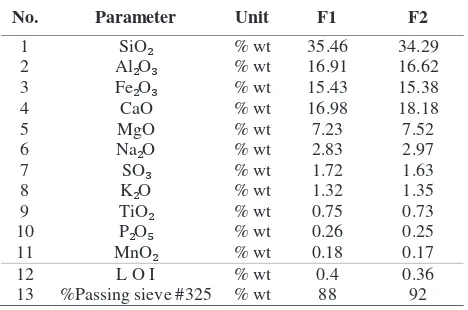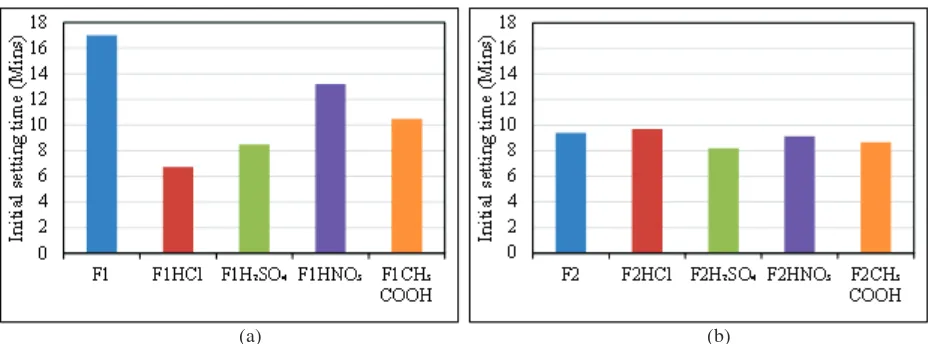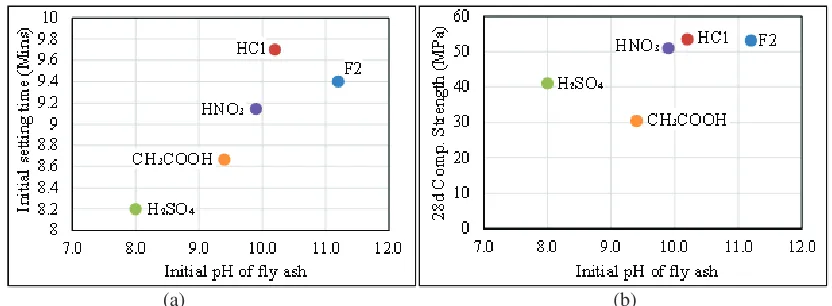Effect of adding acid solution on setting time and compressive strength of high
calcium fly ash based geopolymer
Antoni, Jason Ghorman Herianto, Evelin Anastasia, and Djwantoro Hardjito
Citation: AIP Conference Proceedings1887, 020042 (2017); doi: 10.1063/1.5003525 View online: http://dx.doi.org/10.1063/1.5003525
View Table of Contents: http://aip.scitation.org/toc/apc/1887/1
Published by the American Institute of Physics
Articles you may be interested in
Committees: Green Construction and Engineering Education (GCEE) Conference 2017
Effect of Adding Acid Solution on Setting Time and
Compressive Strength of High Calcium Fly Ash Based
Geopolymer
Antoni
1, a), Jason Ghorman Herianto
1, b), Evelin Anastasia
1, c)and Djwantoro
Hardjito
1, d)Abstract. Fly ash with high calcium oxide content when used as the base material in geopolymer concrete could cause flash setting or rapid hardening. However, it might increase the compressive strength of geopolymer concrete. This rapid hardening could cause problems if the geopolymer concrete is used on a large scale casting that requires a long setting time. CaO content can be indicated by pH values of the fly ash, while higher pH is correlated with the rapid setting time of fly ash-based geopolymer. This study investigates the addition of acid solution to reduce the initial pH of the fly ash and to prolong the setting time of the mixture. The acids used in this study are hydrochloric acid (HCl), sulfuric acid (HSOΏ), nitric acid (HNOΎ) and acetic acid (CHΎCOOH). It was found that the addition of acid solution in fly ash was able to decrease the initial pH of fly ash, however, the initial setting time of geopolymer was not reduced. It was even faster than that of the control mixture. The acid type causes various influence, depending on the fly ash properties. In addition, the use of acid solution in fly ash reduces the compressive strength of geopolymer mortar. It is concluded that the addition of acid solution cannot prolong the rapid hardening of high calcium fly ash geopolymer, and it causes adverse effect on the compressive strength.
INTRODUCTION
The effort to replace cement as construction material had been done by introducing fly ash as the binder with geopolymer reaction. The use of fly ash as a base material is very beneficial, because fly ash is by-product of the combustion products and the resulting CO emissions are 80% lower than Portland cement [1]. The geopolymer reaction commences when the low calcium or high calcium fly ash, a material rich in silica element [2-6], mixed with an alkaline solution of sodium hydroxide (NaOH) and sodium silicate. There was some difficulty when using high calcium fly ash in the geopolymer reaction because of the flash setting or very rapid hardening occurrence on the mixture.
have also found that higher pH fly ash value which correlated to the higher calcium content in fly ash that leads to flash setting of the mixture [12].
Attempts to overcome the rapid setting of geopolymer had been done using superplasticizer [13,14], and sucrose or sugar [15]. The use of superplasticizer and sucrose can increase the time setting time, however, the additives decrease the final compressive strength of the mixture. Subsequent research found that the addition of borax can lengthen the setting time to some extent but still not enough for mass casting [16]. The effort to prolong the setting time of the geopolymer concrete using high calcium fly ash still continues.
The use of hydrochloric acid compounds for fly ash treatment can reduce the calcium level in fly ash was shown by Lieberman et al. [17]. This then raises the possibility that the use of acid to prevent flash setting as well as increase the setting time of high calcium fly ash by lowering the pH level. Tinnea & Young [18] also found that the addition of citrate acid can slow down the hydration process preventing excessive hardening of conventional concrete. The acid is potentially used as a retarder to slow the hydration process on cement. In subsequent research, the use of citric acid as a hydration process retarder on Portland cement also developed [19]. Other researchers also confirmed that the citric acid could slow the setting time on conventional concrete at very early age [20]. Thus, the addition of various acid solutions to fly ash can cause a decrease in pH value and reduce the free CaO levels in fly ash so that the setting time can be extended.
This research evaluates the effect of several acid solutions addition in the high calcium fly ash to its setting time and compressive strength properties of the geopolymer mortar. The acids used in this study are hydrochloric acid (HCl), sulfuric acid (HSOΏ ), nitric acid (HNOΎ ) and acetic acid (CHΎCOOH).
EXPERIMENTAL METHODS
Materials
Fly ash used is high calcium fly ash obtained from Paiton Power Plant, Probolinggo, East Java. This study used two fly ash samples (F1 & F2) taken at different times. The sand used is from Lumajang quarry, East Java, and the gradation is controlled to conform to ASTM C778 [21]. The acids used in the study are 10.5 M hydrochloric acid (HCl), 16.9 M sulfuric acid (H SOΏ ), 16.3 M nitric acid (HNOΎ ) and 17.2 M acetic acid (CHΎ COOH). The alkali solution used in this study was sodium hydroxide (NaOH) and sodium silicate Grade 52. The XRF result and the sieve analysis results are shown in Table 1. From the XRF test results can be seen that the fly ash is categorized as type C based on ASTM C311 [22], with the content of SiO + Al OΎ + FeOΎ more than 50% and CaO levels above 10%.
TABLE 1. Chemical and physical properties of the fly ash.
The composition of mix design for making the geopolymer mortar mixture are as follows; sand to fly ash ratio of 2, free water to fly ash ratio of 0.25, the NaOH molarity is calculated to be 8 M for the given free water mass and
ratio of sodium silicate solution to sodium hydroxide solid was 2.5. All ratio is calculated in weight. Curing of the geopolymer mortar specimens are done oven at 60ºC for 24 hours and then rest at room temperature until testing time. The acid solution was added at 1.67% of the fly ash weight. The addition dosage was adjusted from Kusbiantoro et al [15]. The same amount of acid solution was added to differentiate its influence on the geopolymer properties with different concentration.
The measurement of pH was done in two methods, ASTM D 5239 [23] and using Davidovits [11]. According to the ASTM method, pH testing is done by mixing 20 grams of fly ash into 80 grams of distilled water, stirring until evenly and allowed to stand approximately 15 minutes until the fly ash settles, while according to Davidovits, the pH testing is done by mixing 10 grams of fly ash into 100 grams of distilled water, stirred and allowed to settle. The test was done with digital pH meter with an accuracy of 0.1 decimal with the condition that digital pH meter should only be exposed to water and should not be exposed to fly ash deposit.
The initial setting time was conducted on geopolymer paste, excluding the sand in the mixture, using Vicat needle test based on ASTM C 191 [24]. The compressive strength test was conducted at 7, 14 and 28 days on the mortar specimens. Three replication of the compressive strength test was conducted for each age.
RESULTS AND DISCUSSION
Changes of pH with Addition of Acid Solution
Table 2 shows that the addition of the acid can cause the decrease of pH of the fly ash and distilled water solution. Both F1 and F2 fly ash have pH higher than 11, measured by two methods. F2 have higher pH that F1 shown by measurement from ASTM method, which correlates with the CaO content from XRF measurement. After the addition of 1.67% of acid solution into the fly ash powder, there was a reduction of pH at a different point depending on the acid type. Davidovits [11] mentioned that the higher pH value of fly ash could be an indication about the CaO content, causing the flash setting to occur. The authors suspect that the CaO content of fly ash could be decreasing due to the acidic solution binds to the free CaO in fly ash, shown by the reduced pH. However, the uniformity of fly ash and acid solution is still in doubt due to the low volume of acid solution.
TABLE 2. pH of the fly ash before and after acid solution treatment.
Setting Time of the Geopolymer Paste
The initial setting time is tested using Vicat needle on the geopolymer paste. Fig. 1 shows that there is a significant difference in initial setting time for F1 and F2. The initial setting time of the F2 was about 8 minutes faster than the F1, could be because of the CaO content in F2 fly ash is 2% higher than the F1 fly ash. The pH of the F2 is also higher than the F1, as shown in Table 2.
With the addition of acid solution in the dry fly ash, the initial setting time was considerably faster for F1, while the F2 only shown a relative small change. This could be because of the already short initial setting time of the F2. The similar effect of rapid hardening is also shown by Kusbiantoro et al [15] when citric acid was used. He suspected the reaction is due to the formation of CΎ A which can cause quick hardening. In conventional concrete, CΎ A or tricalcium aluminate reactions result in an acceleration of hydration resulting calcium hydroaluminate (3CaO-AlOΎ -Ca(OH) -nHO or hydroxy-AFm), which makes concrete paste harden faster [25]. The addition of
Fly ash Acid solution Solution (%w FA) ASTM 5239 (20/80) Davidovits method (10/100)
acid into the dry F1 fly ash accelerate its initial setting time about 40-60% when compared to the control. While for F2 samples, the addition of acid accelerates about 8% compared to the control specimen.
The addition of several type of acids namely hydrochloric acid, sulfuric acid, nitric acid, and acetic acid at 1.67% of fly ash weight, did not produce a longer initial setting time of the geopolymer. This result is similar to the previous studies with the addition of citric acid to the geopolymer paste [15]. And the acceleration of setting time was not aligned with the previous studies on the use of acid in the normal concrete, where the citric acid could act as a hydration process retarder on cement [19] and conventional concrete [18].
(a) (b)
FIGURE 1. Initial setting time of fly ash reacted with the different acid solution, for (a) F1 fly ash and (b) F2 fly ash.
Compressive Strength of Geopolymer Mortar
The increase in compressive strength with age is shown in Fig. 2, the compressive strength of the F2 fly ash is higher than the F1 fly ash also correlated with the slightly higher CaO content in the F2 fly ash. For geopolymer mortar with various acid added initially in the fly ash, the addition of 1.67% of acid solution into the F1 fly ash decreases the result of the compressive strength compared to the control geopolymer mortar. Hydrochloric acid had the highest reduction of strength at 7 days testing compared to other acids, the reduction was about 40% compared with the control mortar. There was an increase of the strength at the later age, showing that reduction could be reversed. This result is similar to research on the use of citric acid in conventional concrete that causes the reduction of compressive strength of concrete at very early age [20].
For F2 fly ash, the highest reduction of strength happened on the specimens with acetic acid addition. The specimen did not increase in strength with age on contrary with the specimens with hydrochloric acid. Specimen with the addition of hydrochloric acid and nitric acid still show some increase in the compressive strength up to 28 days, showing that there could be other reaction occurring at the later age beside the initial geopolymer reaction.
(a) (b)
FIGURE 2. The compressive strength of geopolymer mortar for (a) F1 fly ash and (b) F2 fly ash.
Effect of Initial pH of Fly Ash on Setting Time and Compressive Strength
In previous study [26, 27], it was believed that pH could influence the initial setting time and the compressive strength of geopolymer paste. Higher pH values lead to very fast setting times because of the high CaO content in fly ash. Fig. 3 shows the results of initial pH testing of fly ash after the various acid addition measured by Davidovits¶ method to the initial setting time and the compressive strength. Based on the results, it is shown that the addition of sulfuric acid reduced the initial pH greater than other acid solutions. However, the initial setting time that occurs in the paste is much faster than the addition of other acids. The initial setting time was faster for lower pH when the pH is changed using acid solution.
The results also show that at the compressive strength value was lowered when the acid solution was added to the mixture with a minor influence from the pH. The type of acid have more influence on the reduction of the strength, hence adding the acid solution in fly ash would reduce the compressive strength potential of the mixture.
(a) (b)
FIGURE 3. Correlation of initial pH of the fly ash with (a) initial setting time and (b) 28 days¶ compressive strength.
CONCLUSIONS
Based on the results of analysis and discussion in this study, the conclusions can be drawn as follows:
2. The decrease in initial pH of fly ash did not result in an increase of the initial setting time but the opposite occurred. This showed that there was no connection between initial pH and initial setting time when an acid addition is used. The addition of acid solution caused acceleration of the initial setting time of the geopolymer paste consistently showed by sulfuric acid (H SOΏ) mixture. Initial setting time occurs quickly by various degree depending on the acid solution and fly ash material.
3. The addition of the acid solution causes the compressive strength of the geopolymer to be lower when compared to the control. The addition of acetic acid (CHΎ COOH) produced the lowest compressive strength compared with other mixture. Moreover, the decrease of compressive strength did not change with time, in contrast to the mortar geopolymer added with hydrochloric acid (HCl) and nitric acid (HNOΎ), which have slight increase in strength as the age increases.
4. There is a correlation of initial pH with the setting time of the geopolymer concrete with the initial pH of fly ash, with lower pH giving the faster setting time. The compressive strength also influenced by the acid addition however the effect is more correlated to the acid type than the initial pH.
REFERENCES
1. P. Duxson, J.L. Provis, G.C. Lukey, and J.S.J. van Deventer, Cem. Concr. Res. 37, 1590 (2007). 2. H. Yildirim, M. Sümer, V. Akyüncü, and E. Gürbüz, Constr. Build. Mater. 25, 2939 (2011). 3. D.M.J. Sumajouw, D. Hardjito, S.E. Wallah, and B. V. Rangan, J. Mater. Sci. 42, 3124 (2007).
4. A.M. Mustafa Al Bakria, H. Kamarudin, M. Bin Hussain, I. Khairul Nizar, Y. Zarina, and A.R. Rafiza, in
Phys. Procedia (2011), pp. 286±291.
5. N. a. Lloyd and B.V. Rangan, Second Int. Conf. Sustain. Constr. Mater. Technol. 7, 1493 (2010). 6. D. Hardjito and S.S. Fung, Hardjito Fung Concr. Res. Lett. Www.crl.issres.net 1, 115 (2010). 7. Antoni, S. Wibiatma Wijaya, and D. Hardjito, Mater. Sci. Forum 841, 90 (2016).
8. M.T. Junaid, O. Kayali, A. Khennane, and J. Black, Constr. Build. Mater. 79, (2015). 9. E.I. Diaz, E.N. Allouche, and S. Eklund, Fuel 89, 992 (2010).
10. E.I. Diaz-Loya, E.N. Allouche, and S. Vaidya, ACI Mater. J. 108, 300 (2011). 11. J. Davidovits, 1st Eur. Conf. Soft Miner. Compiegne, Fr. 1, 25 (1998).
12. Antoni, S. Wibiatma Wijaya, and D. Hardjito, Mater. Sci. Forum 841, 90 (2016).
13. P. Chindaprasirt, T. Chareerat, and V. Sirivivatnanon, Cem. Concr. Compos. 29, 224 (2007). 14. A.A. Aliabdo, A.E.M. Abd Elmoaty, and H.A. Salem, Constr. Build. Mater. 123, 581 (2016). 15. A. Kusbiantoro, M.S. Ibrahim, K. Muthusamy, and A. Alias, Procedia Environ. Sci. 17, 596 (2013). 16. Antoni, S.W. Wijaya, J. Satria, A. Sugiarto, and D. Hardjito, Mater. Sci. Forum 857, 416 (2016). 17. R.N. Lieberman, X. Querol, N. Moreno, Y. Mastai, and H. Cohen, Fuel 184, 69 (2016).
18. J. Tinnea and J. F. Young, ³Influence of Citric Acid on Reactions in the System 3CaO· Al2O3=CaSO4·2H2O-CaO-H2O,´J. Am. Ceram. Soc., vol. 60, no. 9±10, pp. 387±389, (1977)
19. G. Möschner, B. Lothenbach, R. Figi, and R. Kretzschmar, Cem. Concr. Res. 39, 275 (2009).
20. G. Velazco, J. M. Almanza, D. A. Cortés, and J. C. Escobedo, ³Effect of Citric Acid and the Hemihydrate Amount on the Properties of a Calcium Sulphoaluminate Cement,´ Mater. Construcción, vol. 64, no. 316, pp. 1±8, (2014).
21. ASTM C 778, ³Standard Specification for Standard Sand,´ Annu. B. ASTM Stand., vol. 14, pp. 15±17, (2009) 22. ASTM C311-04, Annu. B. ASTM Stand. 04.02, 204 (2005).
23. ASTM D 5239, ³Standard Practice for Characterizing Fly Ash for Use in Soil Stabilization,´ Annu. B. ASTM Stand., vol. 4, pp. 98±100, (2004)
24. C. Astm, Annu. B. ASTM Stand. 191-04 1 (2008).
25. S. Pourchet, L. Regnaud, J.P. Perez, and A. Nonat, Cem. Concr. Res. 39, 989 (2009).
26. Antoni, S.W. Wijaya, and D. Hardjito, ³Compressive Strength of Geopolymer Based on the Fly Ash Variation´, Materials Science Forum, vol. 841. (2016)
27. J. J. Ekaputri, M. Bahrul Ulum, Triwulan, B. Ridho, T. E. Susanto, and M. M. Al Bakri Abdullah, ³A Comprehensive Characterization and Determination of Fly Ashes in Indonesia Using Different Methods,´



